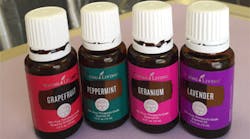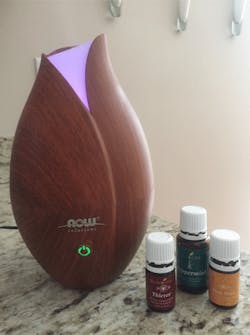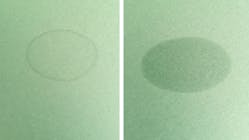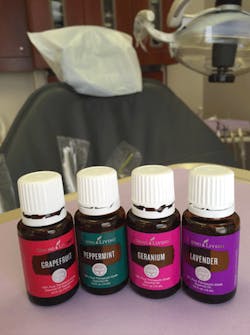Dental professionals have expressed a lot of interest in and asked many questions about using essential oils in their dental practices. It is important that we understand the basics of essential oils—not only for use within the dental practice but so we can educate our patients who are currently using them or who are seeking recommendations for natural remedies. I recently had the opportunity to talk with Jacquelyn Ezzell, an expert on this topic. This is what I learned.
How did you become interested in essential oils?
I originally got involved with essential oils 25 years ago when I was in school to become an aesthetician. I learned about the usage of essential oils in skin care and was instantly intrigued about studying other ways that essential oils can be used.
Why are essential oils called "essential oils?" What is "essential" about them?
An essential oil is naturally obtained by distillation and is purely from a flower or plant, whereas a fragrance is chemically made to mimic the smell of a plant or flower. "Essential, when it pertains to oil, means a concentrated liquid that is essential to the plant's health and viability; it is the blood, if you will, of a plant—the nutrition that makes the plant grow, flower, and survive. A better way to put it is that these oils are the immune systems or healing powers of plants.
How are essential oils used?
Essential oils can be used many ways. They can be diffused into the air using a cold-water diffuser. Cold water is important because it does not change the chemical makeup of the oil. Essential oils can be applied topically. They can be mixed with carrier oils to facilitate spreading them onto a greater surface area of the skin. Essential oils can also be ingested. They can be added to water, placed into a capsule, and taken as a supplement, or they can be added to food for flavor enhancement.
Are all essential oils made equally? Can they be unsafe?
Essential oils that are sent to market are definitely not the same, and many can be unsafe or volatile due to the way they have been derived or distilled. It is an expensive process to properly steam or distill the liquid from a plant, and if it is not done correctly, the oil can break down or become volatile when used.
If you know your oils are pure, like those from Young Living, it is best to use a carrier oil when applying them to the skin. This allows for the fatty acids in the carrier oil to mix with the essential oil, so the oil can be spread over a larger skin surface with diluted potency. Since pure essential oils are extremely potent, they can be too strong for people with skin sensitivities or allergies, and a very small amount is all that is needed. The carrier oil provides a perfect delivery system to the skin.
If you currently use essential oils and are unsure of the purity of your oils, there is a simple way to test their purity: Put a single drop of oil on a piece of construction paper. If it evaporates quickly and leaves no ring, it is pure. If it leaves a ring, it has likely been diluted with an oil of some sort by the manufacturer (figures 1 and 2).
Figures 1 and 2: To test the purity of an oil, place a single drop on a piece of construction paper. If it evaporates quickly and leaves no ring, it is pure. If it leaves a ring, it has likely been diluted with an oil of some sort by the manufacturer.
How can I learn more about them?
There are many oil companies, and it can be overwhelming to decide which ones have the highest quality and safety. Your best bet is to find a few of the top companies and read everything you can about their practices and distillation processes.
When I first was introduced to Young Living, this is the first thing I did. I spent a lot of time learning about their practices and those of other companies, and I found that, of the companies I looked at, Young Living offered the most ethical, purest grade of oil on the market. I found that the other companies’ oils were not all pure; inferior ingredients and distillation processes were used to save money, resulting in inferior oils.
One easy way to identify synthetic oils is by the usage of the words "fragrance," "fragrance oil," "natural fragrance," or "perfume" on the labeling.
If I want to start using essential oils, what should I do first?
I cannot speak to the education offered by any company other than Young Living,but I know that Young Living's website has extensive information about the process by which the oils are derived, how to use them, which oils can be used in food or directly on the skin, and which oils need carrier oils. There are also many blogs on Pinterest and on the Internet that discuss the use of essential oils.
There are two general ways that I search for information about using essential oils. If I am interested in learning about the uses of a particular oil, I will search for the name of the oil that I am interested in. For example, I'd type “geranium + Young Living essential oil” into a search engine. If I am interested in learning about which oils to use for a given symptom or condition, I will search "Young Living Essential Oils + [the condition]." There are times when one particular oil may be the best for a given condition and times when oils should be blended for optimal outcomes.
What are your three favorite oils, and how do you use them?
My three favorite oils areLavender, Joy, and Peppermint.
Lavender can be used on the feet and in diffusers to aid with sleep. It is also an oil that you can keep in your medicine cabinet for cuts and burns or to help prevent scarring.
Joy is my second favorite oil. It is uplifting when it is diffused or used with a carrier oil on the skin. It is a natural antidepressant, and it is also wonderful as a perfume or as an ingredient to make natural deodorant.
Although it's very hard to just pick three, my third would be Peppermint. It has so many uses: A drop in a glass of water helps with nausea, a drop on the back of the neck helps with stress or to increase energy, inhaling it from the hands can relieve a headache or migraine. It can open up the sinuses and relieve congestion, as well. It is one of the most potent oils, and only the tiniest drop goes a long way.
How can essential oils be used in dental practices?There are many ways to incorporate essential oils into a dental practice. One way is to mix a few drops of oil in a clean bottle with distilled water and spray it into the air to create an antiseptic or therapeutic experience. This is done much more easily with a diffuser, as a diffuser can run continuously or alternate on and off every 30 seconds for multiple hours.
Diffused oils can be used for many purposes: (1) For a calming or relaxing effect,try Lavender, Petitgrain, Frankincense, or Stress Away; (2) for an energizing or uplifting effect, try Citrus Fresh, Grapefruit, Lemon, Peppermint, Energy, or Joy; and (3) for a cleasing effect,try Purification or Thieves.
An easy solution to calm an anxious patient is to use an oil known for being calming, such as Lavender, Petitgrain or Stress Away. For extremely anxious adult patients, try letting them inhale Bergamot, Frankincense, or a combination of the two. These oils have a balanced chemistry and can sometimes help settle down an anxious patient.
To help with relaxation during a stressful dental procedure, place a drop on the patient's bib. If you have a particularly nervous patient, place a drop or two of oil onto a towel, washcloth, or even a Kleenex, so he or she can take deep breaths to inhale the aroma when feeling nervous. For patients who are sensitive to oils, this is a useful alternative to putting the oil on the bib because patients can choose to inhale the oil when necessary without having to do so continuously throughout the procedure.
Essential oils can also be used for energy. We could all use a pick-me-up from time to time. Many grab a coffee or an energy drink, but what if I told you that if you take one drop of Peppermint and apply it to your temples after a deep inhalation (or a few inhalations), you will feel immediately revitalized to finish up your day? Another great use for Peppermint is to relieve sinus congestion. Just place a few drops of peppermint into your hands, rub them together, cup them over your nose and mouth (similar to covering a cough), and take a few deep inhalations. Your sinus congestion will be improved immediately!
For surface disinfection, Thieves essential oil is amazing as a cleaning agent and can be combined with baking soda and distilled water to use on surfaces throughout the practice or in the bathrooms.
Patients with dentures can be taught to use oils to make a homemade natural antifungal disinfecting solution in which to soak their dentures, in lieu of commercially available denture cleaning solutions. Natural recipes are available on the Internet.
You could make your own lip moisturizers to give to patients during treatment or to take home afterward. Again, you can find recipes through Young Living or just by searching the Internet.
Orange oil is known to have a whitening effect when a drop is added to toothpaste the taste is great and the effect is instantaneous.
For patients who oil pull, peppermint oil may be added for breath freshening, and tea tree or cinnamon oil may be added for added antimicrobial activity.
Finally, offering a patient a warm washcloth with a drop or two of oil to wipe the hands and face is a lovely way to conclude an appointment.
Editor's Note: This article first appeared in Pearls for Your Practice: The Product Navigator. Click here to subscribe. Click here to submit a products article for consideration.
Jacquelyn Ezzell has 22 years of experience as an aesthetician and has owned a salon, Jacquelyn's Skin Care and Waterfront Salon in Boston, Massachusetts, since 1999. In addition, she taught courses for licensed professionals, Advanced Aesthetics and Realities of Owning Your Own Business, for three years. She recently accepted a new position with Essentials in Woburn, Massachusetts, as an instructor of product ingredient analysis and the use of essential oils in skincare and wellness. Jacquelyn has a website to educate the public about using essential oils in safe, fun, and creative ways. For more information about essential oils, contact her at [email protected]. She is happy to answer any of your questions and help you get started.
Pamela Maragliano-Muniz, DMD, is an editorial director for Pearls for Your Practice: The Product Navigator, an e-newsletter from DentistryIQ and Dental Economics. She was a dental hygienist before earning her DMD from Tufts University School of Dental Medicine and her certificate in advanced prosthodontics from the UCLA School of Dentistry. She teaches and also maintains a private practice in Salem, Massachusetts. Her passion for prevention has stayed with her throughout her career, and in 2010 her practice was named the Adult Preventive Care Practice of the Year by the American Dental Association.









